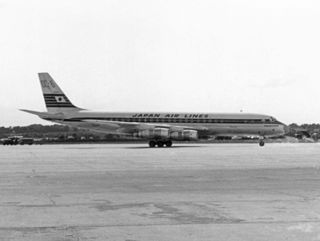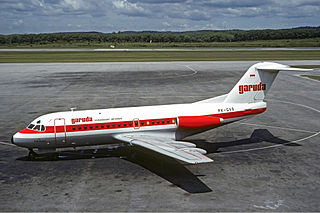
An aviation accident is defined by the Convention on International Civil Aviation Annex 13 as an occurrence associated with the operation of an aircraft, which takes place from the time any person boards the aircraft with the intention of flight until all such persons have disembarked, and in which a) a person is fatally or seriously injured, b) the aircraft sustains significant damage or structural failure, or c) the aircraft goes missing or becomes completely inaccessible. Annex 13 defines an aviation incident as an occurrence, other than an accident, associated with the operation of an aircraft that affects or could affect the safety of operation.
Garuda Indonesia is the flag carrier of Indonesia, headquartered at Soekarno–Hatta International Airport. A successor of KLM Interinsulair Bedrijf, it is a member of SkyTeam and the second-largest airline of Indonesia after Lion Air, operating scheduled flights to a number of destinations across Asia, Europe, and Australia from its hubs, focus cities, as well as other cities for Hajj. It is the only Indonesian airline that flies to the European airspace.

The Convair 880 is an American narrow-body jet airliner produced by the Convair division of General Dynamics. It was designed to compete with the Boeing 707 and Douglas DC-8 by being smaller but faster, a niche that failed to create demand. When it was first introduced, some aviation circles claimed that at 615 mph (990 km/h), it was the fastest jet transport in the world. Only 65 Convair 880s were produced over the lifetime of the production run from 1959 to 1962, and General Dynamics eventually withdrew from the airliner market after considering the 880 project a failure. The Convair 990 was a stretched and faster variant of the 880.

The Convair 990 Coronado is an American narrow-body four-engined jet airliner produced between 1961 and 1963 by the Convair division of American company General Dynamics. It was a stretched version of its earlier Convair 880 produced in response to a request from American Airlines: the 990 was lengthened by 10 ft (3.0 m), which increased the number of passengers from between 88 and 110 in the 880 to between 96 and 121. This was still fewer passengers than the contemporary Boeing 707 or Douglas DC-8, although the 990 was 25–35 mph (40–56 km/h) faster than either in cruise.

The Fokker F28 Fellowship is a twin-engined, short-range jet airliner designed and built by Dutch aircraft manufacturer Fokker.
PT Lion Mentari Airlines, operating as Lion Air, is an Indonesian low-cost airline. Based in Jakarta, Lion Air is the country's largest privately run airline, the second largest low-cost airline in Southeast Asia and the largest airline of Indonesia. With Wings Air and Batik Air, Lion Group is the country's largest airline's group. The airline operates domestic as well as international routes, which connects different destinations of Indonesia to Singapore, the Philippines, Malaysia, Thailand, Australia, India, Japan and Saudi Arabia, as well as charter routes to Mainland China, Hong Kong, South Korea and Macau, with more than 630 flights per day.
PT Merpati Nusantara Airlines, operating as Merpati Nusantara Airlines, was an airline in Indonesia based in Central Jakarta, Jakarta. It operated scheduled domestic services to more than 25 destinations in Indonesia, as well as scheduled international services to East Timor and Malaysia. The word merpati is Indonesian for "dove", and Nusantara is a Javanese word found in the Pararaton meaning "the outer islands", referring to the Indonesian archipelago. The airline was based at Soekarno-Hatta International Airport, Jakarta. It also maintained both a maintenance and simulator facility at Juanda International Airport, Surabaya. The Merpati Training Centre at Surabaya housed Fokker F-27, AVIC MA60 and CN-235 full motion simulators.
Avianca Guatemala is an airline headquartered in Guatemala City. Aviateca was under government ownership and remained so until 1989 when it joined the TACA-organised Airline Alliance of Central America and was privatized. It was fully integrated into TACA, which later merged with Avianca.

Tigerair Mandala was a low-cost airline headquartered in Jakarta, Indonesia and an associate company of the Singapore-based Tigerair Group. The former full service airline repositioned itself as a budget airline/low-cost carrier (LCC) following a year-long grounding in 2011 caused by debt woes. Mandala resumed operations in April 2012 following an injection of fresh capital by Indonesian conglomerate Saratoga Investment Corp which took over 51% of the airline, with partner Tigerair taking up 33.3% and the rest by creditors.
Spantax S.A. was a Spanish leisure airline headquartered in Madrid that operated from 1959 to 1988. Spantax was one of the first Spanish airlines to operate tourist charter flights between European and North American cities and popular Spanish holiday destinations and was considered a major force in developing 20th-century mass tourism in Spain. Its popularity and image faded from the 1970s onward when a series of crashes and incidents revealed safety deficits, which, combined with rising fuel costs and increasing competition, resulted in the company facing severe financial difficulties that led to its demise in 1988.

The McDonnell Douglas DC-9 is an American single-aisle airliner designed by the Douglas Aircraft Company. After introducing its heavy DC-8 in 1959, Douglas approved the smaller, all-new DC-9 for shorter flights on April 8, 1963. The DC-9-10 first flew on February 25, 1965 and gained its type certificate on November 23, to enter service with Delta Air Lines on December 8. With five seats across in economy, it had two rear-mounted Pratt & Whitney JT8D low-bypass turbofans under a T-tail for a cleaner wing, a two-person flight deck and built-in airstairs.

Kemayoran Airport also spelled Kemajoran Airport, was the principal airport for Jakarta, Indonesia, from 8 July 1940 until 31 March 1985, when it was replaced by Soekarno–Hatta International Airport.

Japan Air Lines Flight 472 was a flight from London to Tokyo via Frankfurt, Rome, Beirut, Tehran, Bombay, Bangkok and Hong Kong. On September 24, 1972, the flight landed at Juhu Aerodrome near Bombay, India instead of the city's much larger Santacruz Airport and overran the runway, resulting in the aircraft being written off after being damaged beyond economic repair.

Garuda Indonesian Airways Flight 150 was a scheduled Indonesian domestic passenger flight from Kemayoran Airport, Jakarta to Sultan Mahmud Badaruddin II Airport, Palembang. On September 24, 1975, Flight 150 crashed on approach due to poor weather and fog just 2.5 miles from the town of Palembang. The accident killed 25 out of the 61 passengers and crew on board, and one person on the ground.

Garuda Indonesian Airways Flight 708 was a scheduled domestic passenger flight in Indonesia by Garuda Indonesian Airways from Jakarta to Manado, with stopovers in Surabaya and Makassar. On 16 February 1967, while operating the last segment of the flight from Makassar to Manado, the Lockheed L-188C Electra airliner crashed on landing at Mapanget Airport in Manado, killing 22 out of 84 passengers and eight crew on board.











